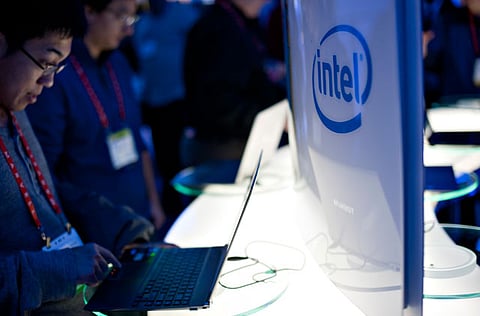Intel to invest $4.1b in ASML
Aims to speed development of a costly, advanced chip-making technique

San Fransisco/Frankfurt: Intel Corp, the world’s largest semiconductor maker, agreed to invest as much as $4.1 billion (Dh15.05 billion) in Dutch chip-equipment maker ASML Holding NV in an effort to shave two years from the time to adopt new production techniques.
The US company will take an initial 10 per cent stake in ASML for about $2.1 billion, and later another 5 per cent for about $1 billion, pending shareholder approval, Santa Clara, California-based Intel said on Monday. ASML also will get about $1 billion more from Intel in stages.
ASML rose as much as 11 per cent in Amsterdam. The Veldhoven, Netherlands-based company is in talks with Samsung Electronics Co and Taiwan Semiconductor Manufacturing Co to sell as much as another 10 per cent of its shares and receive investments in research and development, chief executive officer Eric Meurice said on a conference call today.
Intel aims to speed the development of a costly, advanced chipmaking technique known as extreme ultraviolet — or EUV — lithography, which is used to make semiconductors that are more powerful even as they become tinier.
Intel also is trying to help ASML step up the transition to a new chipmaking standard that relies on 450-millimetre disks of silicon, compared with the current 300-millimetre standard — a shift will enable manufacturers to produce more chips at a faster pace.
‘Technical transitions’
“We’re asking for two extremely large technical transitions to occur at ASML, and it was beyond their capabilities on their own,” Intel chief operating officer Brian Krzanich said in an interview.
Industrywide demand for new ASML machines means “it becomes a good investment for our shareholders.”
Intel’s backing will help cut two years off the time it takes to begin producing chips using both new manufacturing methods.
Intel has used investments like this to create state-of-the-art factories and production techniques that help set it apart from other chipmakers.
“Intel realizes they need 450 sooner than anyone can give it to them,” said Patrick Wang, a New York-based analyst for Evercore Partners Inc.
“If they see a limit, down the road, which presumably they are, you could argue” it’s a good use of cash. He rates Intel shares equal weight.
Early access
The transition to larger wafers will deliver a reduction of 30 per cent to 40 per cent in the cost of a chip, according to Krzanich.
Intel’s cash won’t guarantee early access to the new tools or give it control over ASML, he said.
ASML may raise the minimum price of 39.91 euros (Dh180.14) per share that it offers to additional investors after 45 days, depending on the stock’s performance, Chief financial officer Peter Wennink said on Monday, adding that the company isn’t handing out voting shares to customers because it wants to stay “fully independent.” None of the participating customers may raise their stake to more than 19.9 per cent under the programme for six years.
Europe’s largest seminconductor-equipment maker expects “new commercial opportunities” from the programme and may hire as many as 1,200 engineers to help speed the rollout of the new technologies, Meurice said.
ASML rose as much 4.38 euros to 44.13 euros for its biggest intraday increase since April 2008. The stock traded at 43.65 euros as of 9.24am in Amsterdam. Intel rose less than 1 per cent to $26.17 yesterday at the New York close. That left the stock up 7.9 per cent this year.
Separately, Intel rival Advanced Micro Devices Inc on Monday said second-quarter sales fell 11 per cent from the previous period, compared with an earlier forecast for a gain of as much as 6 per cent, citing weaker-than-expected sales in China and Europe, as well as tepid consumer demand.
AMD, the No 2 maker of processors for personal computers after Intel, had previously forecast that second-quarter sales would rise 3 per cent, plus or minus 3 per cent.
Sign up for the Daily Briefing
Get the latest news and updates straight to your inbox


